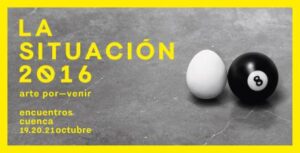Art to-come. Encuentros Cuenca. 18-21 de octubre 2016

International meeting that took place in Cuenca, España, 18th-21st October 2016 to discuss the situation of artistic practice in Iberoamerica. It borrows its name from a previous meeting that also took place in Cuenca in April 1993, in the context of a crisis that affected economy, society and culture in the first nineties. >>> Read more
Among the participants: Isidoro Valcárcel Medina, Luis Camnitzer, María Ruido, Rogelio López Cuenca, María Cañas, Wilfredo Prieto, Mujeres Creando, Dionisio Cañas, Nicolás Paris, la Internacional Errorista, Daniela Ortiz, Rolf Abderhalden, Juan Domínguez, Federico Guzmán, Sally Gutiérrez, Glenda León, Roberto de la Torre, Manuela Zechner, Terrorismo de Autor, Daniel Miracle, Somos Nosotros, Colectivo Out-ziders, Ni arte ni educación, Miguel Ángel Rego, Aïda Gómez, Jordi Ferreiro, Anja Schneider, Rubén Marín, Andrés Senra, Anna Katarina Martín, Mariano Orte and others.
What we normally understand by art practice is a kind of production and experience that remains, to a great extent, dependant on the notion of “social welfare”. In the era of maximum relevance of the myth of the “welfare state”, artists went as far as thinking about extending art practice to all citizens. But, how do artists position themselves after the collapse of that myth?
What happens when “welfare” is not only not a reality, but isn’t even on the horizon? And what to do about those that are excluded?
The “welfare state”, a locus for the realisation of “human rights”, has been replaced by the “precarious state”, where those rights are no longer fundamental. Segregation and war are no longer negative values: they are part of the project of a hierarchical society, complicit with neoliberal capitalism. The internal precariousness of developed or developing societies has a matching narrative in the accepting of misery and terror in less-developed societies. And, in between, migrations are no longer voyages in search of growth and welfare, but dramatic and repressed exoduses. The “state of exception” has become a fact of everyday life, and a norm. (>> Historical context)
Art practices exhibit the consequences of these violent adjustments, and they respond to them seismographically, but they can also intervene in this space of tension, producing places for experimenting with dissidence.
On the one hand, the gradual conversion of culture into an object of consumption after World War II is evident. In an increasingly spectacular manner, in the context of the contemporary “city brands”, art is presented as a tourist attraction, as an ostentatious collector’s item for the elites, and as inane entertainment for everyday life. In any case, art appears, in this context, as a practice bereft of conflict.
At the same time, a full repertoire of strategies of resistance and intervention has been developed throughout the Twentieth Century: from Dadá and the diverse productivist movements, including Situationist, feminist, and post-colonial practices, all the way to Latin-American conceptualisms, institutional critique, and the activisms of the last few decades. In resonance with these strategies of resistance and intervention, critical practices, both individual and collective, set in the scenario of different manifestations of social conflicts, continue to be developed.
Finally, taking into account the spectacular and mercantile displacement of social values, emphasised by the imposition of the neoliberal model, art practice itself appears as a practice of resistance. The “uselessness” of art, or, rather, of poetic activity, is, in itself, a counter-hegemonic value that artists can reclaim. Not only to defend a position of resistance, but also as a potential for imagining new horizons and the institutions of new fictions that can allow the development of commons-based practices.
What we propose is to manifest, share, and debate art practices that dispute this normalised “state of exception”. On the one hand, we want to inquire into how its social context has been re-framed, what strategies of resistance and survival have been developed, and what alternative horizons can be deployed from there. Also, obviously, to highlight how art practices have been directly involved with social movements that have attempted to resist and to elaborate escape routes from the violent impositions of the “state of exception”.